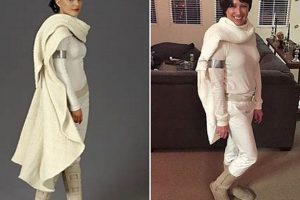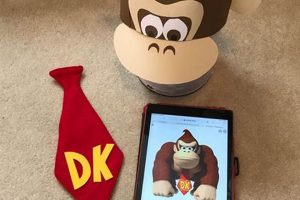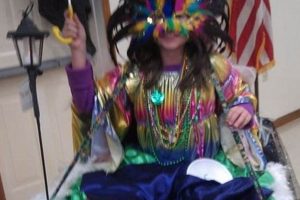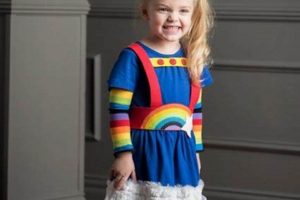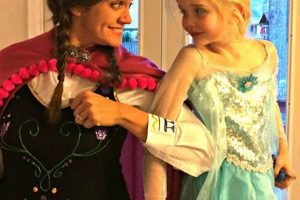The construction of homemade costumes replicating the extraterrestrial characters from the Toy Story franchise is a popular do-it-yourself activity. This involves individuals creating attire that emulates the appearance of these three-eyed, green-skinned figures, typically for occasions such as Halloween, cosplay events, or themed parties. Examples include using green clothing, crafting antennae headbands, and designing large oval eyes to adhere to the garment.
Engaging in such projects offers several advantages. It presents a cost-effective alternative to purchasing pre-made costumes. Furthermore, it allows for personalized customization and creative expression. Historically, the appeal of homemade costumes has stemmed from their affordability and the satisfaction derived from crafting unique items. The Toy Story alien character, with its simple yet distinctive design, lends itself well to such endeavors.
The subsequent sections will delve into specific methodologies for constructing such costumes, exploring various material options, outlining step-by-step construction guides, and examining design considerations for different age groups and skill levels. Furthermore, the article will address safety concerns and offer tips for achieving a visually accurate and durable representation of the characters.
Construction Pointers for Toy Story Alien-Inspired Attire
The following guidelines are intended to facilitate the creation of a durable and recognizable costume replicating the Toy Story aliens. These suggestions address material selection, construction techniques, and safety considerations.
Tip 1: Prioritize Green Fabric Selection: Optimal material choices include fleece, felt, or cotton blends. These fabrics offer a balance of comfort, durability, and ease of manipulation. The specific shade of green should closely match the character’s on-screen appearance.
Tip 2: Accurately Replicate the Ocular Features: Construct large, oval-shaped eyes from white felt or craft foam. Paint or adhere black pupils. Ensure proportional accuracy relative to the overall costume scale. Mounting the eyes securely to the headpiece is critical for maintaining structural integrity.
Tip 3: Fabricate Three-Fingered Gloves: Adapt standard gloves by sewing together the ring and pinky fingers to create a three-fingered configuration. The glove material should match the costume’s primary fabric for visual consistency.
Tip 4: Design a Supportive Headpiece: The headpiece should be lightweight and comfortable to wear. Consider using a padded headband or a custom-fitted hat as a base. Securely attach the eyes and antennae to prevent detachment during wear.
Tip 5: Employ a Consistent Color Palette: Maintaining color consistency across all costume components is essential for achieving a cohesive and accurate representation. Reference official Toy Story imagery for precise color matching.
Tip 6: Reinforce Seams and Attachments: Utilize durable stitching techniques to reinforce all seams and attachment points. This will enhance the costume’s longevity and prevent premature degradation due to stress or movement.
Tip 7: Prioritize Safety and Visibility: Ensure the costume allows for unobstructed vision and movement. If worn in low-light conditions, incorporate reflective elements to enhance visibility and minimize the risk of accidents.
Adhering to these guidelines will contribute to the creation of a visually compelling and structurally sound recreation. Careful planning and execution are paramount to achieving a successful outcome.
The subsequent section will address advanced techniques and material considerations for enhancing the costume’s realism and durability.
1. Green fabric selection
The selection of green fabric is a foundational element in crafting a do-it-yourself alien costume from the Toy Story franchise. This material choice is not merely aesthetic but directly influences the costume’s visual accuracy, wearer comfort, and overall durability. The chosen hue of green must closely resemble the animated character’s iconic skin tone to ensure immediate recognition. Furthermore, the fabric’s texture and weight impact the costume’s drape and movement. For instance, a lightweight, breathable fabric is more suitable for warmer climates or extended wear, while a thicker material might be preferred for colder environments or increased structural support.
Consider the practical implications of fabric choice. A non-stretch woven fabric like felt, while inexpensive and easy to manipulate, may restrict movement and lack the fluidity of a knit fabric. Conversely, a stretch knit, such as fleece, offers greater comfort and freedom of movement but requires more advanced sewing skills to prevent puckering or distortion. The dye quality is also a critical consideration; substandard dyes may fade or bleed during washing, compromising the costume’s appearance. Reputable fabric stores can provide information regarding dye fastness and appropriate care instructions. Real-world examples demonstrate the impact of fabric choice: a costume crafted from high-quality fleece will exhibit a softer, more plush appearance, while one made from inexpensive felt may appear stiff and less visually appealing. Proper fabric choice impacts construction techniques and long-term maintenance.
In summary, the seemingly simple decision of selecting green fabric is a critical determinant in the success of a homemade Toy Story alien costume. It impacts visual accuracy, wearer comfort, durability, and construction complexity. A thoughtful approach to fabric selection, considering factors such as color, texture, weight, and dye quality, significantly contributes to the final product’s overall quality and longevity. The challenges lie in balancing cost, skill level, and desired aesthetic qualities, ultimately linking back to the broader theme of achieving a high-quality, homemade costume through informed decision-making.
2. Three-eyed design accuracy
The precision in replicating the three-eyed design of the Toy Story aliens is paramount to the success of any do-it-yourself costume endeavor. This design element serves as the most immediately recognizable feature, significantly impacting the costume’s overall fidelity to the source material. Inaccurate representation diminishes the costume’s recognizability, potentially resulting in misidentification or a diminished aesthetic impact. The size, shape, spacing, and color of the eyes directly influence how effectively the costume evokes the intended character. For instance, oversized eyes, incorrectly spaced, can create a comical or distorted effect, while accurately rendered eyes instantly establish the character’s identity.
Several
practical considerations impact the execution of this design element. Material selection plays a crucial role; options range from painted foam to pre-fabricated plastic components. Accurate templates or patterns are essential for maintaining consistency and symmetry across the three eyes. Furthermore, the method of attachment to the headpiece or garment must be robust to prevent detachment during wear, which would severely compromise the costume’s appearance. Examples abound: a costume featuring eyes crafted from meticulously painted craft foam, securely attached to a custom-fitted headpiece, presents a far more convincing portrayal than one utilizing hastily cut felt shapes glued to a flimsy headband.
In conclusion, achieving accuracy in the three-eyed design is not merely an aesthetic preference but a fundamental requirement for a successful homemade Toy Story alien costume. It directly influences recognizability, visual impact, and the overall quality of the final product. While challenges exist in material selection, pattern creation, and attachment methods, prioritizing precision in this key design element elevates the costume from a generic green alien to a distinct and recognizable recreation of a beloved character. The underlying principle connects back to the broader concept of detailed execution in achieving a high-quality, convincing costume.
3. Antennae construction stability
Antennae construction stability represents a critical aspect within the broader context of “alien toy story costume diy”. The structural integrity of the antennae directly impacts the overall aesthetic and functional success of the costume. Unstable antennae, prone to bending, breaking, or detaching, detract from the intended visual representation of the character. The selection of materials and construction techniques directly causes the level of stability achieved. For example, using flimsy wire as a core material or failing to adequately secure the antennae to the headpiece results in an unstable structure susceptible to damage. The practical significance lies in ensuring the costume maintains its intended appearance throughout its use, whether during trick-or-treating, cosplay events, or other costume-wearing activities. Real-life examples often demonstrate the consequences of neglecting this element; homemade costumes frequently suffer from drooping or broken antennae, diminishing their overall visual appeal.
Further analysis reveals that antennae construction stability is influenced by multiple factors. The weight of the antennae material, the design of the supporting structure, and the method of attachment all contribute to the final result. Lightweight materials, such as craft foam or felt, require less robust support structures compared to heavier options like sculpted clay or plastic. Employing a sturdy internal frame, such as wire or PVC pipe, provides added reinforcement. The attachment method, whether glue, stitching, or mechanical fasteners, must withstand the stresses of movement and handling. Practical applications involve carefully selecting materials based on their weight and durability, designing a supporting structure that distributes stress evenly, and utilizing attachment techniques appropriate for the chosen materials. This understanding contributes to enhanced structural integrity.
In summary, antennae construction stability is an indispensable element in crafting a successful “alien toy story costume diy”. Its importance stems from its direct influence on the costume’s aesthetic appeal and functional durability. Addressing the challenges of material selection, structural design, and attachment methods is crucial for achieving a visually accurate and long-lasting representation of the character. The core message underscores the necessity of prioritizing structural integrity in costume construction, linking back to the broader theme of creating a high-quality, visually compelling, and durable homemade attire.
4. Proportional body representation
Proportional body representation constitutes a crucial, albeit often overlooked, element within the context of “alien toy story costume diy.” The accurate depiction of the alien’s body proportions directly impacts the costume’s overall visual fidelity and recognizability. Discrepancies in proportions, such as an excessively elongated torso or disproportionately large head, can detract from the intended character portrayal, resulting in a less convincing or even comical representation. The effect is analogous to viewing a distorted caricature; the essence of the character may be present, but the deviation from accurate proportions diminishes the overall impact. A costume neglecting proportional accuracy may still be identifiable as a Toy Story alien, but it will lack the visual appeal and authenticity of a carefully crafted counterpart.
Achieving accurate proportional body representation in such do-it-yourself projects necessitates careful planning and execution. This includes accurate pattern creation or modification, precise fabric cutting, and attention to garment construction techniques. For example, a costume designed for a small child will require different proportions compared to one intended for an adult, demanding adjustments to the pattern and construction to maintain visual accuracy. Practical applications involve utilizing accurate measurements, employing mannequins or dress forms to assess fit and proportion during construction, and referencing official Toy Story imagery to ensure adherence to the character’s established dimensions. Failure to account for these considerations can result in a costume that appears ill-fitting or distorted, negating the effort invested in other aspects of the project.
In summary, proportional body representation represents a fundamental, often underestimated, aspect of a successful “alien toy story costume diy” project. Its significance lies in its direct impact on the costume’s visual accuracy and the recognizability of the depicted character. While challenges exist in adapting patterns and construction techniques to different body sizes and shapes, prioritizing accurate proportions elevates the final product from a generic alien costume to a convincing and visually appealing recreation of a beloved character. This emphasis reinforces the overarching theme of detailed execution as a key determinant of quality in homemade costume construction.
5. Comfortable headpiece assembly
Headpiece assembly directly affects the wearability and overall satisfaction associated with a do-it-yourself alien costume, inspired by Toy Story. The connection between a comfortable headpiece and a successful costume construction hinges on the wearer’s ability to endure extended periods of use without discomfort or irritation. An ill-fitting or poorly designed headpiece can cause headaches, chafing, and restricted movement, detracting from the costume’s intended aesthetic impact. For example, a headpiece constructed from rigid materials with abrasive edges will invariably lead to discomfort, discouraging the wearer from fully engaging in the costume-wearing experience. This negatively
impacts the overall perception of the completed Toy Story alien costume project.
Practical considerations for comfortable headpiece assembly include material selection, weight distribution, and secure attachment methods. Lightweight, breathable materials, such as padded foam or fabric-covered headbands, minimize stress on the wearer’s head and neck. Even weight distribution prevents pressure points and reduces the likelihood of discomfort. Secure attachment of decorative elements, such as eyes and antennae, is essential to prevent them from shifting or rubbing against the wearer’s skin. The implementation involves selecting appropriate materials based on their weight and breathability, designing a headpiece that evenly distributes weight across the wearer’s head, and employing attachment techniques that minimize the risk of irritation. This is integral to positive wearability.
In summary, comfortable headpiece assembly plays a critical role in achieving a successful and enjoyable alien costume endeavor. Its importance stems from its direct impact on the wearer’s comfort and the overall wearability of the costume. While material selection, weight distribution, and attachment methods present assembly challenges, prioritizing comfort ensures a positive and enduring experience. This underscores the necessity of balancing aesthetic considerations with practical design principles, ensuring the final result is both visually appealing and comfortable to wear.
6. Secure seam reinforcement
Secure seam reinforcement constitutes a critical, often unseen, element in the construction of a durable and visually appealing do-it-yourself Toy Story alien costume. This aspect of construction transcends mere aesthetic considerations, directly impacting the costume’s longevity and resistance to wear and tear during use. Failure to adequately reinforce seams can lead to premature degradation, compromising the overall investment of time and materials.
- Material Selection for Strength
The choice of thread and reinforcement materials directly influences seam durability. Utilizing high-tensile strength thread, such as polyester or nylon, is paramount, particularly at stress points. Incorporating reinforcement tape or fusible interfacing along seam lines provides an additional layer of protection against stretching and tearing. For instance, reinforcing the seams of a bulky fleece alien costume requires heavier-duty thread and interfacing compared to a lighter costume constructed from cotton.
- Stitch Density and Technique
Increasing stitch density within a seam enhances its strength and resilience. A shorter stitch length concentrates the thread, providing greater resistance to pulling forces. Furthermore, employing techniques such as backstitching at the beginning and end of each seam secures the thread ends, preventing unraveling. The implementation of a serger or overlock machine, when available, creates a professionally finished seam that encapsulates raw edges, preventing fraying and adding significant strength.
- Stress Point Identification and Targeted Reinforcement
Certain areas of the Toy Story alien costume, such as the attachment points of the antennae, the armholes, and the crotch seam, are subject to increased stress during movement. Identifying these critical stress points allows for targeted reinforcement. This may involve adding extra layers of fabric, incorporating gussets to distribute stress, or using specialized stitching techniques, such as bar tacks, to secure seams against heavy strain. Failure to address these stress points results in a higher probability of seam failure and costume damage.
- Seam Finishing for Longevity
Proper seam finishing techniques contribute significantly to the costume’s longevity. Raw edges, if left exposed, are prone to fraying and unraveling, weakening the seam over time. Techniques such as zigzag stitching, serging, or binding the edges with bias tape prevent fraying and protect the seam from wear. Selecting the appropriate seam finishing technique depends on the type of fabric used and the desired level of durability. A well-finished seam not only enhances the costume’s appearance but also extends its lifespan.
The principles of secure seam reinforcement, therefore, represent more than a mere technicality in do-it-yourself costume construction. It is an investment in the longevity, durability, and overall quality of the final product. While the visual aspects of an “alien toy story costume diy” project often receive primary attention, a failure to address seam reinforcement will inevitably lead to premature failure and diminished enjoyment of the finished costume. From the choice of thread to the implementation of specialized stitching techniques, each element contributes to the creation of a resilient and visually enduring representation of the beloved animated character.
7. Size appropriate pattern
The correlation between pattern selection and size accuracy is vital for a successful “alien toy story costume diy” project. An improperly sized pattern, regardless of meticulous construction, will yield an ill-fitting costume, diminishing its aesthetic appeal and impeding movement. This directly impacts the wearer’s experience and the overall effectiveness of the intended character representation.
- Anthropometric Measurement Accuracy
Precise body measurements are fundamental for pattern selection and subsequent adjustments. Relying on generalized sizing charts, without accounting for individual variations, increases the risk of an inaccurate fit. Measurements should include height, chest circumference, waist circumference, hip circumference, and inseam length. These measurements provide a baseline for selecting a pattern size that approximates the wearer’s dimensions, minimizing the need for extensive alterations. An example is a child’s costume requiring adjustments for a longer torso or wider shoulders to ensure comfortable and accurate proportions.
- Pattern Grading and Scaling Considerations
Patterns designed for commercial use often employ standardized grading systems. Understanding these systems is crucial for accurate scaling. Scaling a pattern up or down to accommodate different sizes requires careful attention to maintain proportional integrity. Simply increasing or decreasing all dimensions uniformly can distort the design, resulting in an unnatural or unflattering fit. Each pattern piece must be individually adjusted to preserve its intended shape and relationship to other components. For instance, expanding a bodice pattern necessitates adjusting the corresponding sleeve and shoulder dimensions to maintain a balanced silhouette.
- Fabric Type and Drape Influence
The selection of fabric significantly impacts the final fit and appearance of the costume. Different fabric types possess varying degrees of stretch, drape, and weight, influencing how the pattern pieces conform to the body. A stretchy knit fabric will yield a more form-fitting costume compared to a rigid woven fabric, even when utilizing the same pattern. Compensating for fabric drape requires adjustments to the pattern’s ease and seam allowances. For example, a costume constructed from a heavy, stiff fabric may require additional
ease for comfortable movement, necessitating alterations to the pattern’s dimensions. - Ease Allowance and Mobility
Ease allowance, the difference between the garment’s dimensions and the wearer’s body measurements, is critical for comfort and freedom of movement. Insufficient ease restricts mobility, while excessive ease results in a baggy or ill-fitting costume. Different types of ease serve distinct purposes. Wearing ease allows for basic movement, while design ease contributes to the garment’s overall style and silhouette. Determining the appropriate amount of ease requires considering the costume’s intended use and the wearer’s personal preferences. For example, a costume intended for active wear will require greater ease in the armholes and legs to facilitate unhindered movement, necessitating adjustments to the pattern’s ease allowances.
In conclusion, selecting a size-appropriate pattern is integral to the success of an “alien toy story costume diy” venture. Precise measurements, pattern scaling proficiency, fabric drape consideration, and ease allowance management are all paramount. Attending to these details yields a costume that not only accurately represents the intended character but also fits comfortably and allows for unhindered movement, ultimately elevating the overall experience. This detailed process demonstrates the link between accurate pre-construction and a superior final product.
Frequently Asked Questions
The following addresses common inquiries regarding the construction of homemade costumes replicating the alien characters from the Toy Story franchise. These questions pertain to various aspects of the project, ranging from material selection to safety considerations.
Question 1: What are the most suitable materials for creating the green skin effect?
Fleece, felt, and cotton blends are frequently employed. Fleece offers a soft texture and warmth, while felt provides a more rigid structure and is easier to manipulate. Cotton blends offer a balance of comfort and durability. The specific choice depends on the desired aesthetic and functional properties of the costume.
Question 2: How can the three-eyed design be accurately replicated without specialized equipment?
Templates can be created using cardboard or paper. These templates serve as guides for cutting the eye shapes from felt, craft foam, or other materials. Painting or attaching pupils can then be completed with basic craft supplies. Symmetry and accurate spacing are critical for achieving a recognizable result.
Question 3: What methods are recommended for ensuring the antennae remain stable and upright?
Wire or pipe cleaners can be used as internal supports within the antennae. These supports provide rigidity and prevent the antennae from drooping. The supports should be securely attached to the headpiece or garment to prevent detachment.
Question 4: How can comfort be maximized when wearing a homemade alien costume?
Selecting breathable fabrics, such as cotton or linen, minimizes overheating. Ensuring a proper fit, without constricting movement, enhances comfort. Padding any rigid components of the costume, such as the headpiece, reduces the risk of chafing or irritation.
Question 5: What safety precautions should be observed during the construction process?
Using safety scissors or a craft knife under supervision minimizes the risk of injury. Applying non-toxic adhesives and paints prevents exposure to harmful chemicals. Ensuring adequate ventilation during painting and gluing reduces the inhalation of fumes.
Question 6: How can the durability of a homemade alien costume be enhanced for repeated use?
Reinforcing seams with durable stitching techniques prevents tearing. Selecting high-quality fabrics that resist fading and shrinking extends the costume’s lifespan. Storing the costume properly, away from direct sunlight and moisture, minimizes degradation.
These answers provide foundational guidance for addressing common challenges encountered during the construction of these costumes. Careful planning and attention to detail are essential for achieving a successful and enjoyable result.
The subsequent section will delve into advanced techniques for customizing and personalizing the alien costume design.
Conclusion
The preceding discussion has comprehensively examined the multifaceted aspects of “alien toy story costume diy.” The discourse encompassed material selection, design accuracy, structural stability, and practical construction techniques necessary for realizing a successful, homemade rendition of the iconic Toy Story character. Each element, from fabric choice to seam reinforcement, contributes demonstrably to the overall quality and longevity of the resulting attire.
The meticulous execution of each construction detail underscores the potential for crafting a compelling and durable costume. Further independent investigation and refined application of the principles outlined herein may lead to even more advanced and personalized creations, enriching the experience of costume design and replication.


